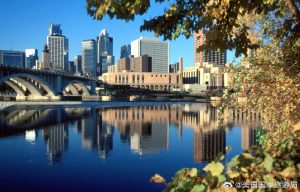
Lobster from Maine, water from Minneapolis. If you want to pick up a bucket and go to the United States for water, remember to skip the middleman and go directly to Minneapolis! You read that right! The city of water in the United States is Minneapolis! The city of water! Minneapolis is the largest city in Minnesota, the United States. The famous Mississippi River flows through the city, and the city is located on the north side of the confluence of the Minnesota and Mississippi Rivers.
Minneapolis is a water-rich city with 20 lakes and wetlands, the Mississippi River riverfront, and numerous streams and waterfalls. In history, Minneapolis was the flour industry capital of the world and an important logging center. Today, the city remains the most important commercial center between Chicago and Seattle. In addition, Minneapolis also has many cultural institutions that attract creators and audiences in various fields of theatre, visual arts, literature and music. Among them, the famous Guthrie Theater is a pioneer of local theaters off Broadway in New York. It is also the city with the second most performance venues after New York.
Since Minneapolis is surrounded by the only waterfall on the Mississippi River, St. Anthony’s Falls, there has been a tradition of using water power since the 1st century BC. In the early days, the forests of northern Minnesota provided resources for the logging industry, and the city used the water from the falls to build 17 sawmills. By 1871, there were 23 businesses on the west bank of the river, including flour mills, wool mills, ironworks, railroad machinery mills, cotton mills, paper mills, and planers. By 1905, Minneapolis produced almost 10% of the flour in the United States. In addition, the Minneapolis Skyway system is the largest enclosed second-floor corridor system in the world. Between the buildings in the city center, it connects 80 city blocks and is 9.5 miles long. The Minneapolis Skyway system not only provides indoor connections to office buildings, but also includes bars, restaurants, bakeries, hotels, government services, retail, gyms, grocery stores, liquor stores, banks, doctors, dentists, masseuses, pharmacies, hair and nail salons It can be said that you can stroll around downtown Minneapolis without going outdoors. The viaduct connecting Northstar Center and Roanoke Building on 7th Street was opened on June 12, 1963. The viaduct is the oldest existing viaduct. Built in 1974, IDS (still the tallest building in downtown Minneapolis) was a pivotal moment for the Skyway network. The building is characterized by skybridges connecting to the building from four directions, integrating the decentralized system at the time. The IDS intersection also features the Crystal Court atrium, which is the largest public space in the network. In 2016, Skyway connected to Bank of America Stadium opened. However, the purpose of Skyway’s design at that time was not because of the cold winter climate in Minneapolis, but to solve the problem of paved sidewalks to ease the traffic problem crossing the road. Later, it was also the real estate developer for the value of their real estate. Therefore, basically in the city center, buildings after the 60-70’s have Skyway connections
发表回复